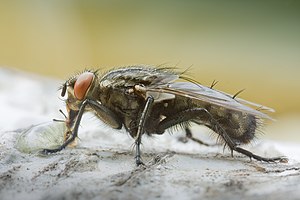Meat flies
| Meat flies | ||||||||||||
|---|---|---|---|---|---|---|---|---|---|---|---|---|

Male meat fly ( Sarcophaga sp.) |
||||||||||||
| Systematics | ||||||||||||
|
||||||||||||
| Scientific name | ||||||||||||
| Sarcophagidae | ||||||||||||
| Macquart , 1834 | ||||||||||||
| Subfamilies | ||||||||||||
|
The meat flies (Sarcophagidae) are a family of the two-winged (Diptera). Around 2500 species of meat flies are known worldwide, around ten of them in Germany.
features
To fly
Meat flies belong to the calyptrate flies, i. that is, they have calyptres, two lobe-shaped appendages of the wings, which usually cover the swinging arches. They are gray or black and often have a checkerboard pattern on the abdomen. The chest area (thorax) has dark longitudinal stripes. They can reach heights of up to 15 millimeters. Their mouthparts are designed to lick up liquids.
Larval development
The larvae are maggot-like and accordingly have no head capsule. In the first stages you breathe through the skin, from the third stage the anterior and posterior stigmas of the tracheal system open .
Way of life
The larvae of the different species of meat fly have developed very different types of food acquisition. They live in different substrates.
Scavengers and faeces
In addition to the predatory larvae, the most primitive species include those that feed on carrion ( necrophagy ). The assessment of their larval stages (for example the gray meat fly ) can be used in forensic medicine to determine the age of a corpse . Others live in the dung of various animals and feed on it ( coprophagia ).
Parasites and Parasitoids
A number of other species are parasitoids that live on or in invertebrate hosts. The host spectrum includes earthworms , snails , millipedes , scorpions , cockroaches , beetles and cicadas . Some species are kleptoparasites . They lie in wait for digger wasps , who bring paralyzed prey into their nests for their brood. Then they in turn lay an egg on this animal; the grave wasp larva is displaced by the meat fly larva, e.g. B. of the types of satellite flies . Other species, such as the larvae of the genus Miltogramma, feed on pollen and nectar in the nests of solitary bees and wasps in a kleptoparasitic manner. Some species are endoparasites of amphibians (gray meat flies on toads) and reptiles (such as lizards and turtles ), as well as mammals (humans can also be attacked). They cause myiasis .
To fly
The adult flies feed on various juices, such as honeydew , nectar , tree saps and the juices of damaged fruits.
Representatives of the meat flies (selection)
Real meat flies - genus Sarcophaga
The larvae of the Sarcophaga species mostly live in carrion or in feces ( coprophagia ). The gray meat fly ( Sarcophaga carnaria ) is very common in Germany and has a body length of 13 to 15 millimeters. The gray meat fly is also called the carrion fly. The females lay their very ripe eggs, from which a larva hatches soon afterwards, in the entrances of earthworm holes or in earthworm piles. The hatched young larvae then actively seek out the earthworms, probably guided by the smell, and penetrate them, often in the area of the belt ( clitellum ). It only takes a few days to develop, after which the earthworm perishes. These flies have several generations per year and overwinter as larvae or pupae.
Satellite flies - genus Senotainia
The satellite flies lurk at the nests of digger wasps , which bring in stunned prey for their larvae. They follow these and then lay an egg on the prey, in which the maggot then develops. The satellite flies include S. albifrons and S. conica .
The larvae of the genus Miltogramma also live in a similar way to the satellite flies , but they live in the nests of solitary bees and wasps from the supplies of their “hosts”, in this case not only stunned insects but also honey and pollen. The larvae of Blesoxipha laticornis are endoparasites in field locusts and those of Agria mamillata are ectoparasites in various insects.
Other types (selection)
literature
- J. and H. Haupt: Flies and mosquitoes - observation, way of life , Augsburg 1998.
- K. Honomichl, Heiko Bellmann: Biology and ecology of insects ; CD-Rom, Gustav Fischer Verlag, Stuttgart 1994.
Individual evidence
- ↑ Mariana Prado Nassu, Patricia Jacqueline Thyssen, Aricio Xavier Linhares: Developmental rate of immatures of two fly species of forensic importance: Sarcophaga (Liopygia) ruficornis and Microcerella halli (Diptera: Sarcophagidae). In: Parasitology Research , Vol. 113, No. 1, 2014, pp. 217-222.
- ↑ Martin Grassberger, Christian Reiter: Effect of temperature on development of Liopygia (= Sarcophaga) argyrostoma (Robineau-Desvoidy) (Diptera: Sarcophagidae) and its forensic implications. In: Journal of Forensic Science , Volume 47, No. 6, 2002, pp. 1332-1336.
- ↑ Mohammad Reza Fakoorziba, Mohammad Assareh, Davood Keshavarzi, Aboozar Soltani, Mohammad Djafar Moemenbellah Fard, Mohammad Zarenezhad: New record of Sarcophaga ruficornis, Fabricius, 1794 (Diptera: Sarcophagidae) from Iran, a flesh fly species importance of medical and forensic species. In: Forensic Sci & Criminal Inves , Volume 3, No. 1, 2017, doi : 10.19080 / JFSCI.2017.03.555602 .
- ↑ Roy Pranabesh, B. Dasgupta: Sarcophaga ruficornis fab (Sarcophagidae: Diptera). As a parasite of the common Indian toad. In: Proceedings of the Indian Academy of Sciences - Section B , Volume 86, No. 3, September 1977, pp. 207-209.
- ↑ Fernando da Silva Carvalho-Filho, Maria Cristina Esposito & Amanda de Azevedo Silva: A further new species of Sarcofahrtiopsis Hall (Diptera: Sarcophagidae) associated with faeces of the disk-winged bat (Thyroptera Spix: Chiroptera) in Brazil and the redescription of the female terminalia of S. cuneata (Townsend). Zootaxa, 3889, 1, pages 118-126, November 2014 doi : 10.11646 / zootaxa.3889.1.7



